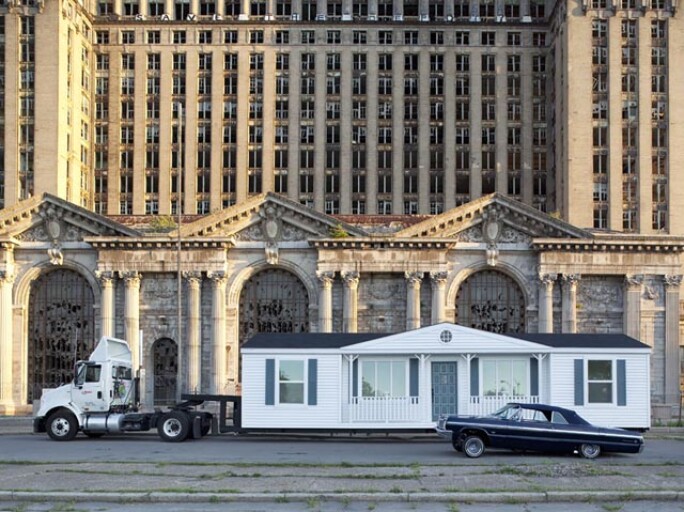A work by the American artist Mike Kelley is currently on display as part of ARTISTS FOR ARTANGEL: A Fund for the Future at the Cork Street Galleries, and is offered for sale in an auction to raise money to support future projects by London-based organisation Artangel.
Mike Kelley was a hugely important cultural figure, and had a profound influence on how contemporary art is experienced by audiences today. Known widely for his performance and installation work (though he also worked extensively in painting, photography and video) he enjoyed major exhibitions at MoMA PS1, Tate Liverpool, the Stedelijk Museum and presentations at the Venice Biennale and Whitney Biennial.

MIKE KELLEY, MOBILE HOMESTEAD, 2010. MUSEUM OF MODERN ART, NEW YORK. COURTESY THE MIKE KELLEY FOUNDATION FOR THE ARTS.
Kelley’s practice presented an unorthodox, yet honest commentary on American culture through the eyes of a voracious image-maker. Kelley’s contribution to the contemporary American art is well-documented, and his untimely death in 2012 sent shockwaves through the art world internationally, such was his significance in the community. Kelley was a great collaborator, and worked with artists and musicians such as Tony Oursler, Raymond Pettibon, Jim Shaw and the band Sonic Youth throughout his career — reinforcing his desire to keep an open discourse with other creative practitioners.
Kelley’s 2010 Artangel project Mobile Homestead was an exact recreation of the childhood home that Kelley grew up in, right down to the décor and layout of the interior. Part of the structure was mounted on to a truck and travelled through Michigan and on to other cities in the States, and a section of the installation remained in Detroit where Kelley decided it would be used as a subterranean working space for artists to complete residencies, projects and “private rites of an aesthetic nature”. Kelley was adamant that there was a level of secrecy and privacy for the artists, and therefore space was not open to the public. It is therefore in this same spirit of covert actions that the work donated by Kelley's collaborators for ARTISTS FOR ARTANGEL was created.

STILL FROM MIKE KELLEY'S MOBILE HOMESTEAD SHOWING THE UNIT IN TRANSIT. © COURTESY THE MIKE KELLEY FOUNDATION FOR THE ARTS.
Mobile Homestead Swag Lamp with Sub-basement box for Mobile Homestead, combines Kelley’s Mobile Homestead Swag Lamp produced prior to the realisation of the Detroit project, alongside a newly commissioned work by Kelley’s collaborators and friends.
These two objects represent one lot in the sale. Submissions by Laurie Anderson, Cameron Jamie, Cary Loren, Paul McCarthy, John Miller, Tony Oursler, Raymond Pettibon, Jim Shaw and Marnie Weber are tantalisingly concealed: the work comprises a locked box in which the artists have placed objects and works that will only be revealed once the work has sold, and been placed in the collection of a new owner.

The Mobile Homestead was part performance and part installation, and through its journey around the United States, Kelley was able to collaborate with several organisations and charities that directly assisted those in need. Social enterprises, medical charities and volunteer organisations such as Local United Network to Combat Hunger, the American Red Cross and A.A were among those to benefit from the Mobile Homestead project.
Over the years, Kelley’s had worked on various models and renders of spaces he had known growning up; Educational Complex was a scale model of every school the artist had attended, and his need to revisit these spaces spurred on a continued exploration of these themes in Mobile Homestead. Kelley declared: “80 percent of these buildings that I had been in for most of my life were the site of some kind of repressed trauma.” The basement was only finally completed after Kelley’s death.
CLICK HERE for further information on the exhibition and sale.
